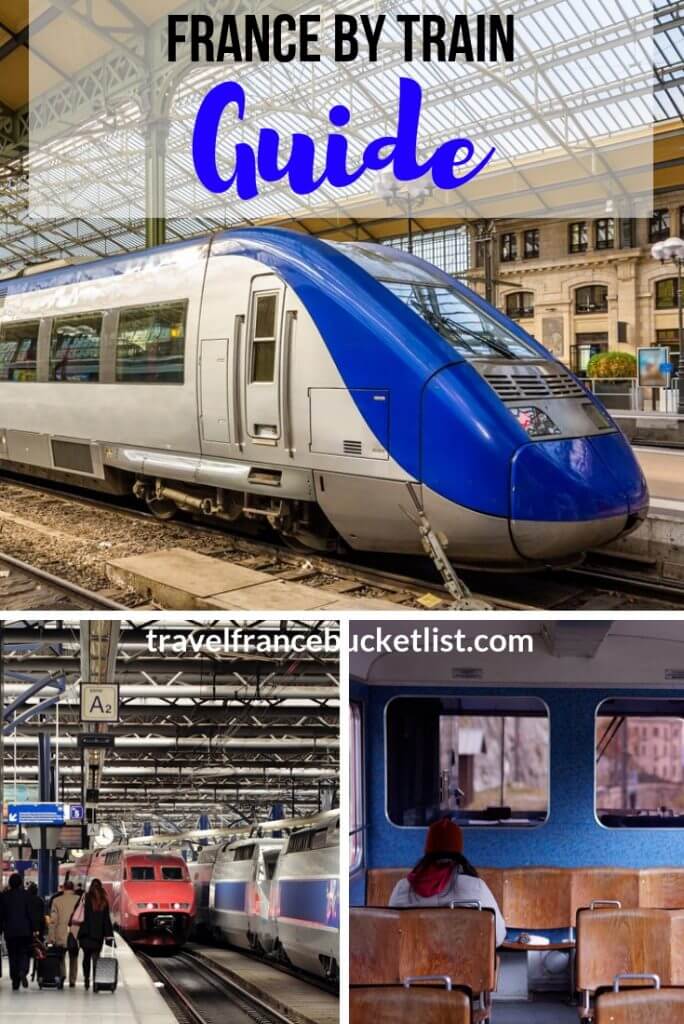Article written by Elisa - Travel Writer & Local in France
This article may contain compensated links. Please read disclaimer for more info.
Train Travel in France
If you’re planning a trip to France, getting around the country couldn’t be easier than by train. Trains in France are one of the best modes of transportation and will get you anywhere you want to go in the country with ease and to or from any neighboring country.
If you’re a first-time visitor and need some assistance with understanding train travel in France, then you’ll want to read this quick guide to France by Train. This guide provides everything you need to ensure traveling by train in France goes smoothly, including information on the different types of trains in France, the best France rail pass for tourists, where to buy your tickets, and just some general tips.
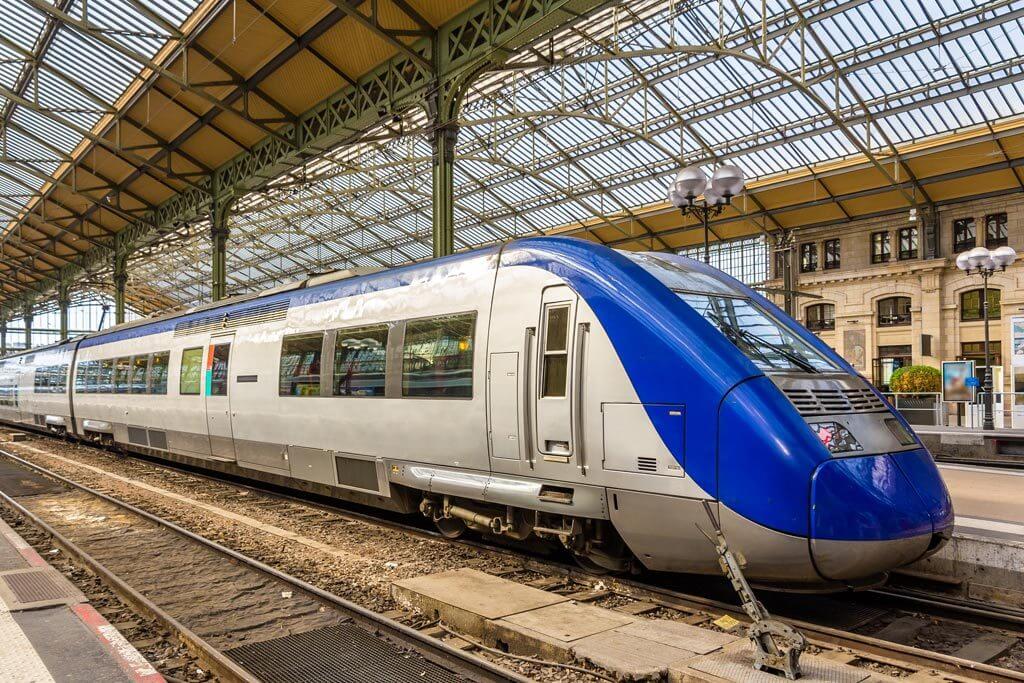
Table of Contents:
- France Train Map
- Types of Trains in France
- How to Buy Tickets for Trains in France
- SNCF’s New Luggage Policy (as of 2024)
- Travel France by Train – Destinations
- France Rail Pass for Tourists
- Getting Around France by Train – Best Tips
France Train Map
The French rail network links all the major French cities and the smaller rural towns and cities of neighboring countries. In the France train map below, the high-speed rail lines are in red, and the other major lines are in brown.
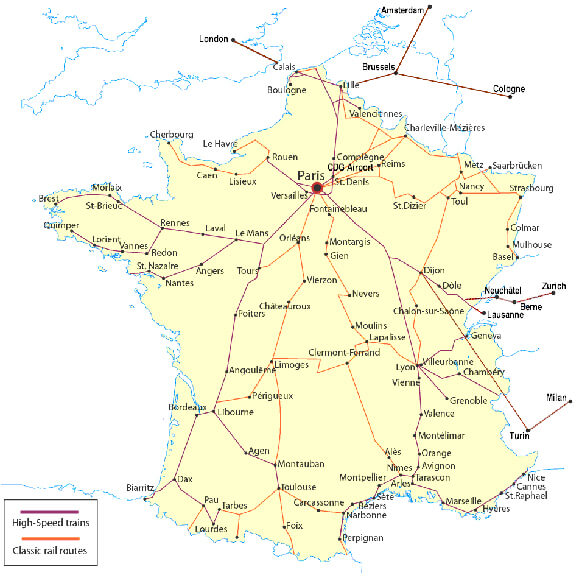
Types of Trains in France
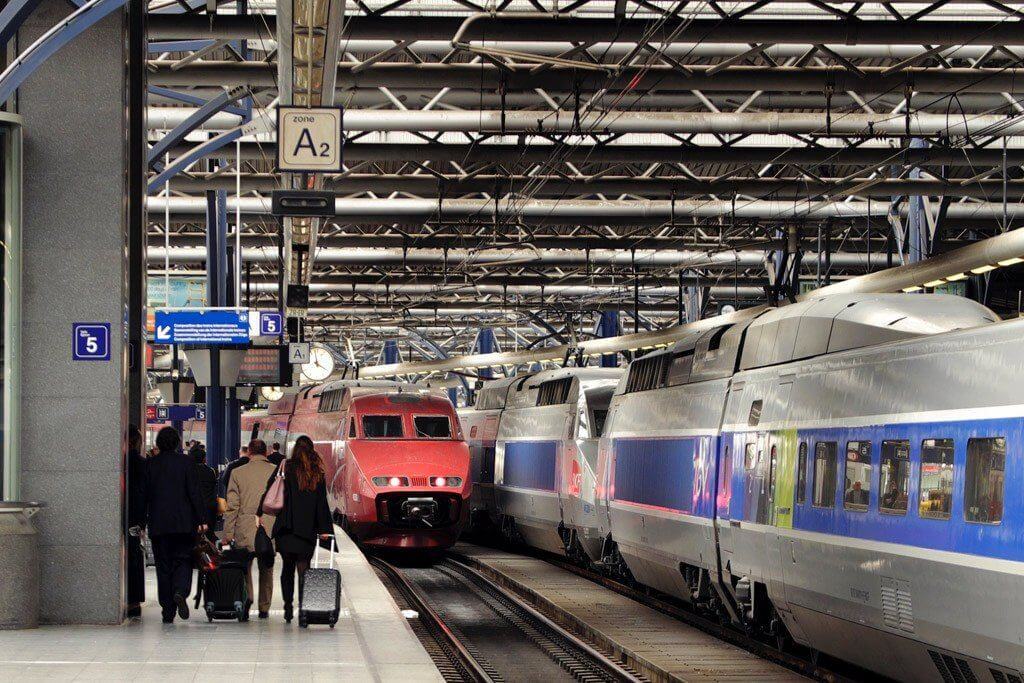
There are various types of trains in France, from local trains to long-distance trains. There are even trains that cross into neighboring countries.
Below, I have provided a brief overview of the various trains in France, so you can understand which trains will get you to your destination,
France Train Travel: First Class or Second Class?
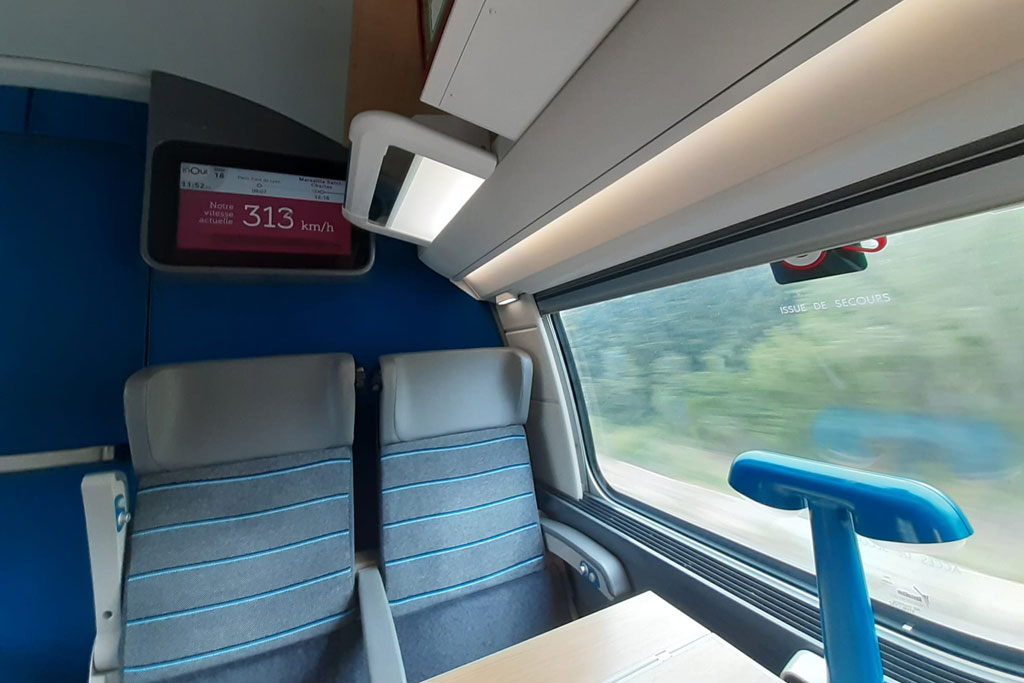
When you travel France by train, you have the option of purchasing a first-class or second-class ticket. Either class is very comfortable with most seats, including drop-down tables and power.
First-class seats are wider and more comfortable than 2nd-class seats, as there are fewer seats per car. There’s also more space for your luggage.
Personally, I find the first class to be less noisy and a place where it’s easier to relax or work (no kids running along the corridors, people talking on the phone, or listening to music with the loudspeaker).
Sometimes, the difference in price between first and second class is minimal, so the extra comfort is well worth it.
Generally, all trains have free Wi-Fi and a café on board, but you are also welcome to bring your own food.
1. TGV Trains (Train à Grande Vitesse)
The TGV train is France’s high-speed rail service, connecting over 230 cities across France and some European cities. At up to 320km/h, these trains will get you where you need to go fast!
Unfortunately, I don’t have a specific TGV map but if you look at the France train map above, the TGV network would correspond to most of the dark red lines.
With TGV Trains, you have the option of traveling first-class, second-class, and (in some TGV lines) business class. Generally, all TGV trains have free Wi-Fi and a café on board, but you are also welcome to bring your own food.
To ride the TGV, you must book a seat reservation (see below on how to purchase train tickets). For the cheapest tickets, book well in advance rather than on the day of travel. Tickets are usually available for purchase around 90 days before the day of travel.
2. Intercités
Intercités trains in France are express trains that connect the main cities within France. They cover longer distances than local trains, but not quite as long as the TGV trains. These trains service over 300 destinations in all the French regions, reaching cities such as Amiens, Orléans, Bordeaux, Caen, Lyon, Reims, Troyes, Toulouse, and Paris.
With Intercités Trains, you have the option of traveling first-class or second-class. Generally, all trains have free Wi-Fi and a café on board, but you are also welcome to bring your own food.
Like the TGV trains, the Intercités trains require advance booking. For the cheapest tickets, book well in advance rather than on the day of travel. Tickets are usually available for purchase around 90 days before the day of travel.
3. OUIGO Trains
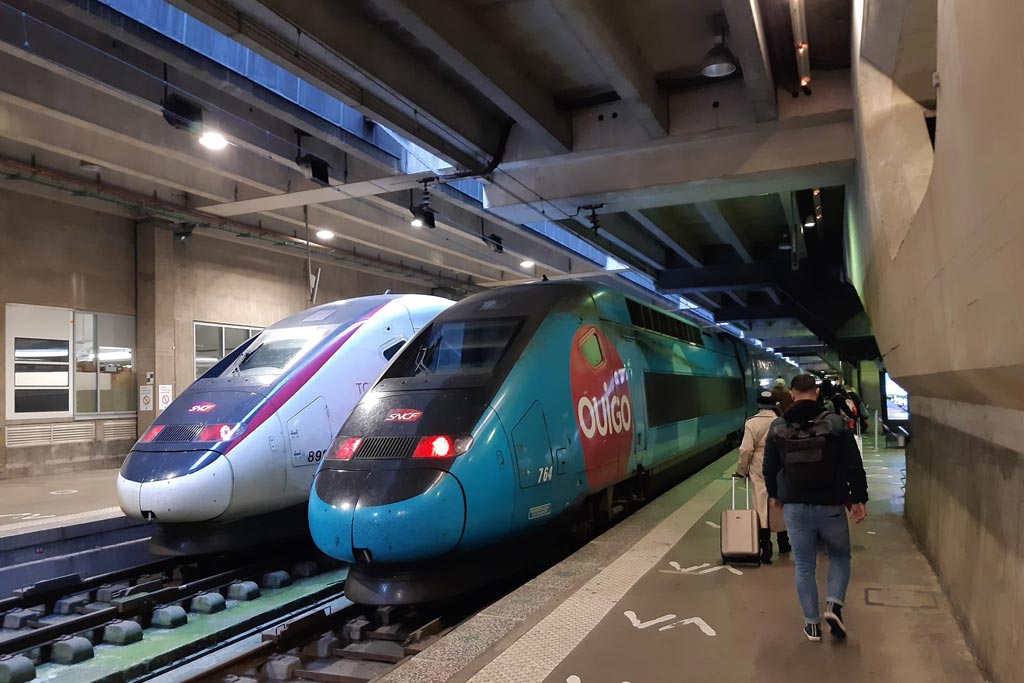
OUIGO is a low-cost rail service company established in 2013 as part of the SNCF group. OUIGO trains only have one class, equivalent to second-class travel. This is why OUIGO tickets are so cheap – from €10 for adults (depending on the destination) and €5 for children.
In OUIGO trains, Wi-Fi and a plug for charging your devices are considered extras (to pay in addition to the train ticket).
4. TER (Transport Express Regional)
TER trains are regional trains in France, usually referred to as local trains. They are ideal for getting between regional French towns and villages.
Like long-distance trains, with TER trains, you can also travel first or second class, but this will change soon (a unique class).
No seat reservation is required to travel on a TER train (you can sit anywhere you like). However, you will require a ticket. Tickets can be purchased as you go or in advance up to 120 days before the day of travel. During the high season in France, main holidays, and long weekends, I recommend booking these train tickets online in advance.
5. AutoTrain
Don’t feel like driving to your destination but need your car once you get there? Well, AutoTrain is the answer! This train runs from Paris Bercy Station to the South of France with your car onboard. So all you need to do is take a comfortable and quick Autorain and meet your car there.
6. Night Train
Some destinations are also covered by night trains – TGV trains or Intercités trains, which also have 4 and 6-bed cabins. Night trains are environmentally friendly and are a great way to save time and money (one hotel night less).
The main lines covered by night trains in France are Paris – Nice, Paris – Toulouse, Paris – Antibes, Paris – Marseille, Paris – Rodez, and Paris – Montauban. There are also international night trains from /to France, with Paris – Vienna being the most famous line.
Update December 2023: two more night train lines are available in France: Paris – Aurillac and Paris – Berlin!
>> Paris-Aurillac in the Cantal leaves in the evening from Paris Austerlitz train station and arrives in Aurillac early in the morning. It is available on weekends and during school holidays in France – Click here to buy your tickets from Paris to Aurillac (or vice-versa)
>> NightJet from Paris to Berlin leaves the German capital in the evening, traveling via Strasbourg, and arrives in Paris early in the morning. For the time being, this service is available 3 times a week, and it will be a daily service from October 2024. The train operator is OBB (Austria) – Click here to buy your tickets from Paris to Berlin (or vice-versa)
7. Eurostar (Train from the UK to France)
The Eurostar (international joint operation) is a high-speed train from England to France that connects France with the UK and Belgium via the Channel Tunnel. One of the most popular Euro trains to Paris, the Eurostar is so fast that it’s, in fact, possible to make day trips from London to Paris or London to Disneyland Paris!
Other French cities served by Eurostar trains are Calais, Lille, Lyon, Avignon, Marseille, Moutiers, Aime-la-Plagne, and Bourg-St-Maurice.
This Euro train has three classes of travel: standard, standard premier, and business. All classes of travel are very comfortable. Standard premier and business classes are served food onboard, while standard class can purchase food at the onboard café or bring their own food. On most trains, Wi-Fi is available onboard the trains and a range of entertainment is via the Eurostar App.
A seat reservation is mandatory on Eurostar (see below for how to purchase tickets). For the cheapest tickets, book your tickets well in advance rather than on the day of travel. Tickets are usually available for purchase around 90 days before the day of travel.
Unlike most of the other trains above, for the Eurostar, you are required to check in before boarding the train.
8. Thalys
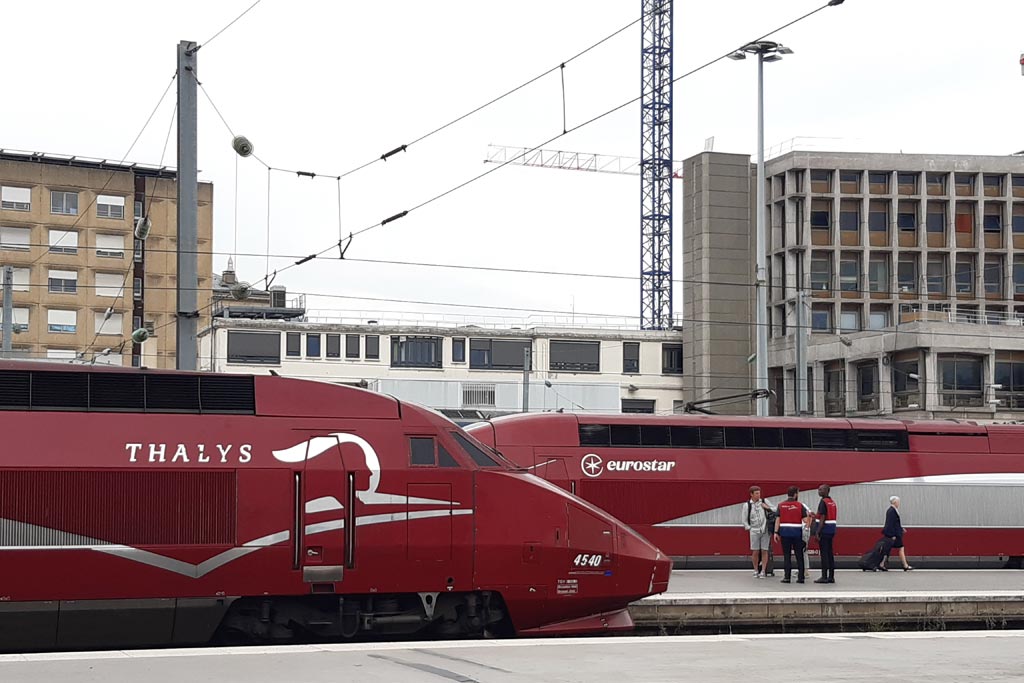
The Thalys is a French-Belgian train operator connecting France with Belgium, the Netherlands, and Germany.
When traveling on the Thalys train, you can purchase a first-class (comfort or premium class) or second-class ticket. Either class is very comfortable with all seats, including drop-down tables and power sockets. All trains have free Wi-Fi and a café on board, but you are also welcome to bring your own food onboard.
A seat reservation is mandatory on Thalys trains (see below for how to purchase tickets). For the cheapest tickets, book your tickets well in advance rather than on the day of travel. Tickets are usually available for purchase around three months before the day of travel.
How to Buy Tickets for Trains in France
There are various ways to buy train tickets in France, depending on your preference. These options are available whether you hold a rail pass and just need to make a seat reservation or if you require a point-to-point ticket.
1. In Train Stations
For the ultimate flexibility, you can just turn up and purchase your ticket at the train station. You can either purchase your ticket at a vending machine or from a ticket window (this is becoming rare, though).
If you don’t speak English, it’s often best to use the vending machines, as you can switch it to English.
However, I don’t recommend this option for long distances, as some train lines are sold out days (or months) in advance.
2. Online on the SNCF Website
Locals in France usually prefer to purchase their train tickets via the SNCF website, which is the official website of the French Railways. You can either purchase your tickets as you go or in advance to secure some good deals. Unfortunately, the English version of the site is not that great, but it is still a good way to purchase tickets online.
You can then choose to print your ticket on your phone or keep it on your smartphone.
3. Online on Omio or Trainline Websites
I recommend that you use Omio to book French train tickets – alternatively – book your train tickets on Trainline here. Both sites are easy to navigate, have great overviews of the train schedules and prices, have lots of information, straightforward booking, and are all in English. (All the things that the SNCF is NOT!)
SNCF’s New Luggage Policy (as of 2024)
Since 15 February 2024, the SNCF has imposed a limit on passengers regarding their luggage, which means that your suitcases will have to respect certain dimensions. The size of baggage allowed depends on the type of train.
1. TGV and Intercités Trains
One person can take up to two pieces of labeled luggage with maximum dimensions of 70 x 90 x 50 cm (suitcase, large backpack, hiking bag, sports bag) and one labeled handbag with maximum dimensions of 40 x 30 x 15 cm (backpack, shopping bag, computer bag).
In addition, it is also possible to travel with “special luggage”: “stroller, folded scooter, musical instrument in a labeled case, pair of skis in a labeled bag, wakeboard or snowboard in a labeled bag,” specifies the SNCF.
2. TER Trains
TER trains do not have a maximum size imposed. “Nevertheless, luggage must be able to be handled by yourself and enter the spaces provided on our regional trains,” SNCF says.
3. OUIGO Trains
For the Ouigos, nothing changes. Passengers already had to respect a size and a number of bags before this new policy. As a reminder, you can board the carry-on baggage of no more than 36 x 27 x 15 cm and one piece of cabin baggage that does not exceed 55 x 35 x 25 cm.
GOOD TO KNOW: While the rules have been in place since 15 February 2024, the SNCF promises to be flexible “until 15 September 2024,” the end date of the “adaptation period.” From September 2024, there will be a fine of 50 euros for non-compliance with the baggage policy.
Travel France by Train – Destinations
1. Train Travel from Paris
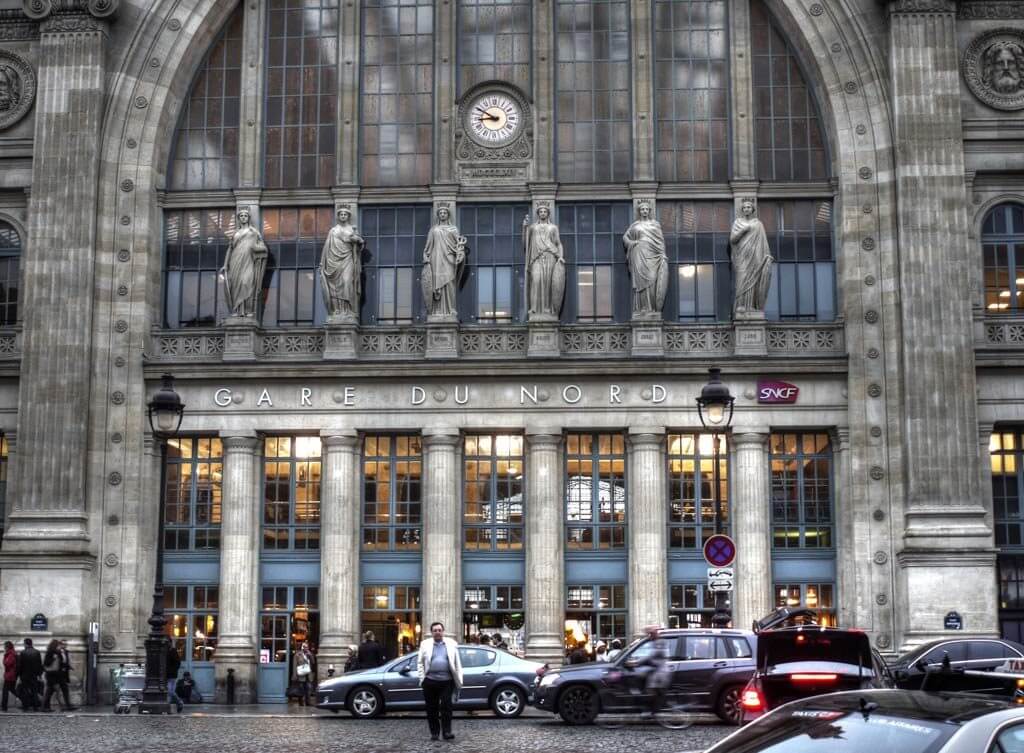
Given many tourists arrive in Paris, this is often the starting point for many train journeys within France. With the trains in Paris, you can pretty much reach anywhere within the country with ease.
Here are some of the main destinations in France served from the train stations in Paris:
» Gare du Nord: Northeast France, Lille, Valenciennes, Calais, London (Eurostar), Brussels, Cologne, and Amsterdam (Thalys)
» Gare de l’Est: Nancy, Metz, Reims, Strasbourg, Colmar, Germany, and Luxembourg
» Gare de Lyon: South of France. Lyon, Dijon, Besançon, Clermont-Ferrand, Marseille, Nice, Montpellier. Mulhouse in the East of France. Switzerland (Geneva, Zurich), Italy, and Catalunya (Girona, Barcelona)
» Gare d’Austerlitz: Tours, Poitiers, Limoges, Bordeaux, Toulouse, Biarritz, Western Spain
» Gare Montparnasse: All TGVs to West of France (Brittany, Brest, Rennes, Nantes)
» Gare St. Lazare: Caen, Cherbourg, Rouen, Le Havre.
2. Train Travel in France
Did you know France is the most visited country on earth? Whether you prefer spending your holidays swimming, hiking, sightseeing, or drinking some of the world’s best wines, it is possible to reach your dream destination in France by train.
Check out our suggested train itineraries:
- Best day trips from Paris by train
- Train itineraries 1 week
- Train itineraries 2 weeks
- Gothic Cathedrals in France train itinerary
3. Euro Train Travel to France
Train travel to France is not exclusive to French trains, so it is possible to travel to France with train companies from abroad. Examples of international cooperations are SNCF – Deutsche Bahn for train travel France – Germany, SNCF – Swiss Rail for train travel France – Switzerland, and SNCF – RENFE for train travel France – Catalonia and Spain.
Below I have listed the most popular international train travel routes to France:
- Need to catch a train from England to France? – take the super-fast and efficient Eurostar. England to France by train was never easier, and Eurostar connects Paris with both the UK and Brussels.
- From Switzerland, you can get a high-speed train to France with TGV Lyria.
- SNCF, in cooperation with Deutsche Bahn, operates frequent trains between France and Germany.
- If you’d like to travel to France by train from Belgium, the Netherlands, or Germany, Thalys operates an efficient train service.
New French destinations from Spain
RENFE (the Spanish train network) chose Lyon to introduce its new AVE fast train service for France. This new service connecting France and Spain began on 13 July 2023 between Barcelona and Lyon with no change of trains. Then, the connection between Madrid and Marseille started on 28 July 2023.
This is great news for Catalan and Spanish who wish to attend the Summer Olympics competitions in Southern France.
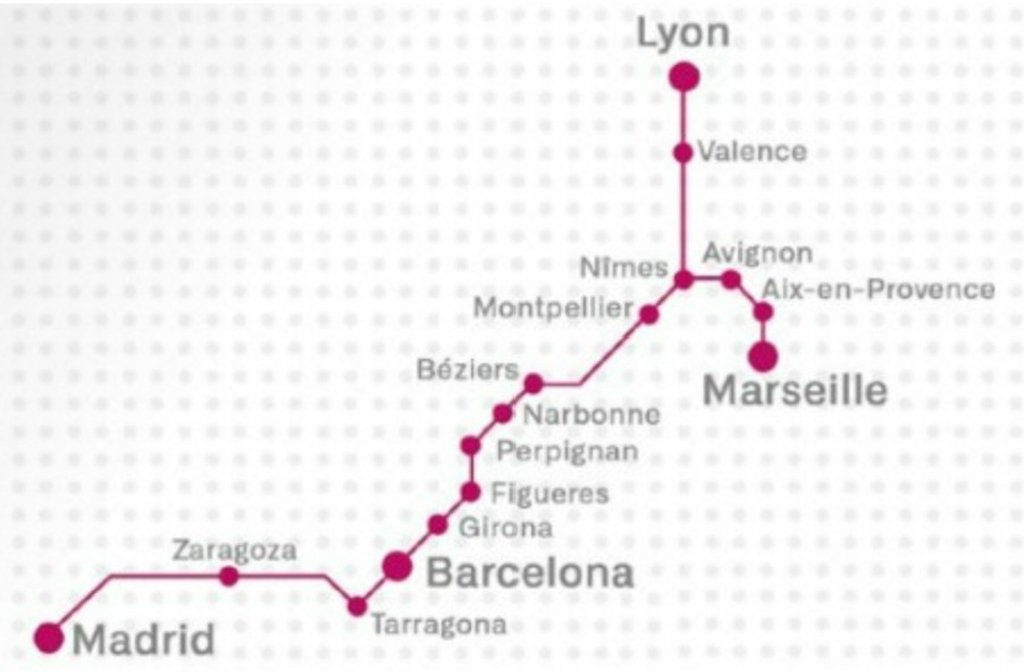
Currently, SNCF trains travel from Paris to Barcelona in less than 10 hours, with 3 routes per day. RENFE will also operate this route but only after the Summer Olympics.
France Rail Pass For Tourists
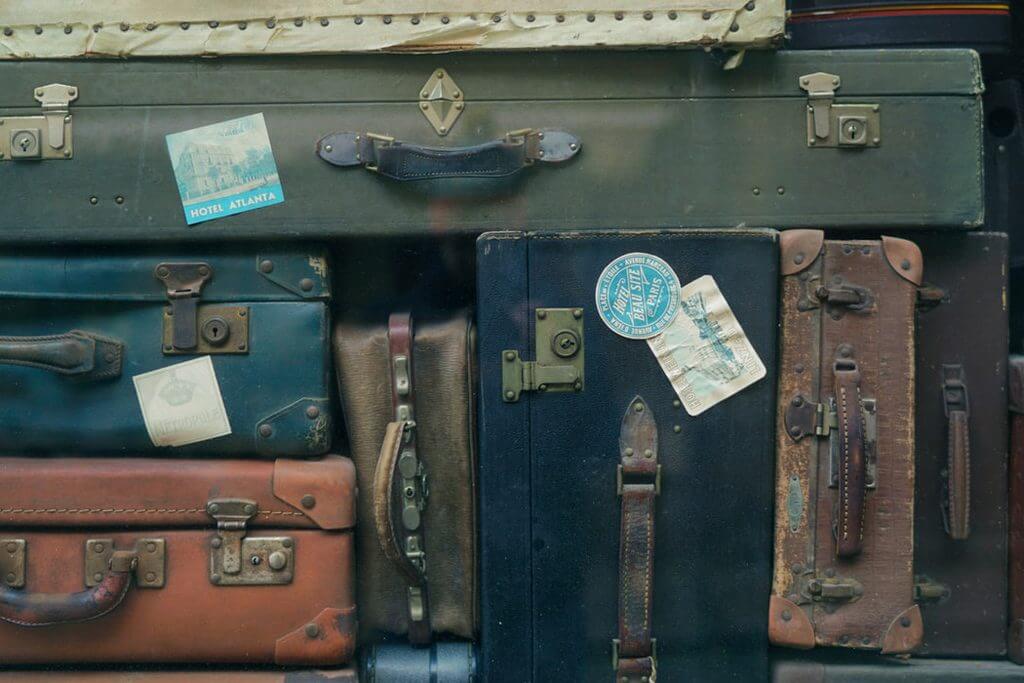
There are a range of different rail passes that you can use to travel France by train. Some passes are solely for train travel in France, while others allow you to travel in France and other European countries. What pass is best for you really depends upon your individual travel plans.
There are various benefits to having a rail pass as opposed to purchasing point-to-point tickets as you go, such as:
- Convenience – no need to purchase train tickets every time you want to take a train.
- Flexibility – given a rail pass provides you with unlimited train travel you can just turn up at the station whenever you like and catch the next train. If you miss a train – no problem catch the next one.
- Save money – this is the main reason people purchase a rail pass. Unless you book your tickets well in advance, last-minute train tickets can be crazy expensive. By having a pass with unlimited travel, you will, in many cases, save money.
- Discounts: many rail passes come with other inclusions of discounts for attractions or other modes of transport.
1. Interrail Pass One Country
For those only traveling in France, the Interrail Pass, One Country is the way to go. This France rail pass provides you with unlimited train travel in France (all France trains, including the TGC, TER, Intercity, etc.) – there is absolutely no limit to the number of times you take a train on any given day.
You can choose a France rail pass based on the number of travel days you will have in France. You can choose from 1 to 8 days of travel within a month. You can also choose to travel first or second class.
Interrail Pass can only be used by European citizens or permanent residents in Europe. If you are a UK resident, you can use this pass too.
When it comes to regional and local trains, just jump on board and sit wherever you like. For fast trains, in most cases, a seat reservation is required in addition to your pass.
With the Interrail Pass One Country, you will also receive discounts on various museums, attractions, cruises, ferries, buses, and hotels.
2. Eurail Global Pass – Multi-Country Pass
If you are visiting France as well as neighboring countries, then the Eurail Global Pass is the better rail pass option. Indeed, with this multi-country train pass, Europe has no secrets for you! This pass provides you will unlimited travel in 31 different European Countries (including France) – there is absolutely no limit to the number of times you take a train on any given day.
You can choose the best train pass for Europe based on how many travel days you will have in Europe. Choose either 3, 5, or 7 days of travel within a month or 10 or 15 days of travel within two months. If you travel by train more frequently, you can also buy a consecutive day travel pass of 15 days, 22 days, one month, two months, or even three months. You can also choose to travel first or second class.
While some trains you can just jump on board and sit wherever you like, remember other trains require you to have a seat reservation in addition to your pass.
How to Use Rail Passes
Generally, most rail passes are still paper-based and require you to write the date of your travel before the first trip of each day. You then simply board the train. If you have made a seat reservation (remember this is mandatory for some trains), you need to find this seat and sit there for the duration of your train trip.
Ticket inspectors will come through the train periodically and ask to see your ticket. You simply show them your rail pass and seat reservation (if you have one).
Getting Around France by Train – Best Tips
To make your train travel in France enjoyable, here are a few additional tips:
1. Train Strikes in France
Train strikes in France can be a major inconvenience, especially if you’re caught off-guard. I tell you all about train strikes in France – strike dates and the best tips to deal with them – in this article about French Train Strikes.
2. Arrive Early at the Station
There is nothing worse than arriving a few minutes before your train is about to depart and having no idea where to go. France train stations can be huge places, and it can be a little daunting to navigate your way around.
Arrive at least 15-20 minutes (perhaps more in huge train stations like Gare du Nord in Paris) before your train is due to depart. This will give you enough time to check the large screens and see which platform your train is leaving from and then find the platform. Once you arrive at the platform, there is often a sign indicating where the train’s carriages are so that you can wait in the appropriate place for easy boarding.
If this is your first time catching a train in Europe, or if you don’t speak French, I’d even recommend giving yourself an extra 10 minutes until you get the hang of things.
3. Bring Snacks for the Train
This is particularly important for long-distance trains. While most trains have a trolley cart that comes around or even a café on board, sometimes, for whatever reason, the trolley doesn’t come, or the café is closed. Even when they are open, they may not have your favorite drink or anything you like. Plus, the food and drinks tend to be expensive.
Most train stations have various convenience stores where you can pick up food and drinks before boarding the train.
4. Validate Tickets before Boarding
If you use point-to-point tickets on regional and local trains, you must validate your ticket before boarding the train. Usually, there is a machine just before you enter the platform where you insert your ticket.
If you are using a pass, nothing is required except boarding the train. If in doubt, always ask the station staff before boarding the train.
5. Never Leave Unattended Luggage
It can be tempting to briefly leave your bag while you walk to a nearby shop for a bottle of water, but you should never leave your luggage unattended – even for a second. Unfortunately, thieves are everywhere, and they are well experienced with taking bags in a split second.
It is also recommended that you store your luggage within eyesight on board the train instead of in the dedicated spaces between the seats and the doors. In most cases, you should be able to store your luggage in the compartments above your seat or below your seat.
When I take a train in France, I never leave my suitcase in the compartments between the seats and the doors.
6. Making Train Connections
Unlike flight connections, you really don’t need much time between train connections. Sometimes, a train connection might involve walking to the other side of the platform. However, at other times you will need to walk from one end of the train station to the other, so leave yourself plenty of time to make your connection – 10 minutes should be plenty.
And there you have it, a quick guide to trains in France. I hope that this guide to the train system in France will help you with getting around France by train. Bon voyage!
Pin it Now & Read it Later
